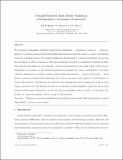Certified reduced basis model validation: A frequentistic uncertainty framework
Author(s)
Patera, Anthony T.; Huynh, Dinh Bao Phuong; Knezevic, David; Patera, Anthony T.
DownloadPatera_Certified reduced.pdf (8.172Mb)
PUBLISHER_CC
Publisher with Creative Commons License
Creative Commons Attribution
Terms of use
Metadata
Show full item recordAbstract
We introduce a frequentistic validation framework for assessment — acceptance or rejection — of the consistency of a proposed parametrized partial differential equation model with respect to (noisy) experimental data from a physical system. Our method builds upon the Hotelling T[superscript 2] statistical hypothesis test for bias first introduced by Balci and Sargent in 1984 and subsequently extended by McFarland and Mahadevan (2008). Our approach introduces two new elements: a spectral representation of the misfit which reduces the dimensionality and variance of the underlying multivariate Gaussian but without introduction of the usual regression assumptions; a certified (verified) reduced basis approximation — reduced order model — which greatly accelerates computational performance but without any loss of rigor relative to the full (finite element) discretization. We illustrate our approach with examples from heat transfer and acoustics, both based on synthetic data. We demonstrate that we can efficiently identify possibility regions that characterize parameter uncertainty; furthermore, in the case that the possibility region is empty, we can deduce the presence of “unmodeled physics” such as cracks or heterogeneities.
Date issued
2011-09Department
Massachusetts Institute of Technology. Center for Computational Engineering; Massachusetts Institute of Technology. Department of Mechanical EngineeringJournal
Computer Methods in Applied Mechanics and Engineering
Publisher
Elsevier
Citation
Huynh, D.B.P., D.J. Knezevic, and A.T. Patera. “Certified Reduced Basis Model Validation: A Frequentistic Uncertainty Framework.” Computer Methods in Applied Mechanics and Engineering 201–204 (January 2012): 13–24.
Version: Author's final manuscript
ISSN
00457825